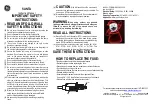
Glossary
X–11
queue to the Hold queue or to discard them.
Finished jobs in the Print queue are automatically
moved to the Printed queue if it is enabled. See
also
IBM Color Spooler.
Printed queue. A storage area for the printer that
moves a finished job from the Print queue to the
Printed queue for temporary storage. You can then
use the IBM Color Spooler to move the job into the
Print queue or the Hold queue, or to discard it from
the printer’s hard disk. See also
IBM Color Spooler.
primary charging. The uniform charging of the
photoconductor drum cartridge with negative
potential.
process color. A mixture of CMYK inks that
simulates a specified color. Process color is the
traditional method for reproducing continuous-tone
color images. See also
spot color
.
protocol adapter. A device for attaching a printer
to a token-ring network through a parallel port. The
AXIS Protocol Adapter: Token Ring, available from
retail suppliers, is the recommended device. See
also
token-ring network.
Q
QuarkXPress. A page layout program developed
by Quark, Inc., for Macintosh computers and PCs
that accepts documents of unlimited length and
includes many word processing functions.
Quickdraw. The graphics and display technology
built into Macintosh computers. Quickdraw is the
equivalent of the PostScript language to send
words and pictures to printers.
R
raster. (1) On a computer monitor or television
screen, the horizontal pattern of lines that forms the
image. (2) A pattern of dots that consist of different
data depths. For example, images with only black-
and-white values are 1-bit (on or off), grayscale
images are 8-bit (256 levels), RGB images are 24-
bit (3 channels of 8 bits each), and CMYK images
are 32-bit (4 channels.) Also called a
bitmap
.
raster image. A series of pixels arranged in scan
lines to form an image.
raster image processor (RIP). A computer
processor that renders PostScript instructions into
dot patterns that are transferred to the final print
medium. Most RIPs use reduced instruction set
computer (RISC) processors to achieve extremely
high throughput. A RIP typically includes a
substantial amount of RAM to store the image as it
is formed and a hard disk to buffer multiple pages.
See also
“ripping.”
red, green, blue (RGB). The colors of computer
monitor phosphors. RGB images are for monitor
display only and are converted to CMYK images
before printing.
registration. In printing, the relative print positions
of images that are printed at different times. For
example, when you print on preprinted forms, the
registration is good if the new image is aligned
correctly with the preprinted image. Print that
extends beyond box edges and text that overlaps
other text are examples of poor registration.
rendering style. A feature of the printer’s color
management software that enables the best
possible translation of color from one color device
to another. The color-rendering styles that you can
choose using their respective color-rendering
dictionary (CRD) name are monitor, photographic,
presentation, and solid color. See also
rendering
style, monitor style, photographic style,
presentation style,
solid-color style.
relocation kit. The packaging and instructions
you need to safely move the printer a substantial
distance.
rendering. See
color-rendering style,
photographic rendering
.
“ripping.” Raster-image processing. See also
raster-image processor.
route power cable. A cable that connects the
power outlet on the optional tray 2 paper feeder
with the power receptacle on the body of the printer.
S
scanner. A device that examines OCR, MICR, or
bar code patterns, generates electrical signals
corresponding to the patterns, and sends the
signals to a computer for processing.
Содержание System Storage
Страница 1: ...IBM Network Color Printer Administrator s Guide S544 5364 01...
Страница 24: ...2 8 Administrator s Guide...
Страница 66: ...A 2 Administrator s Guide...
Страница 76: ...B 10 Administrator s Guide...
Страница 94: ...X 18 Administrator s Guide...








































